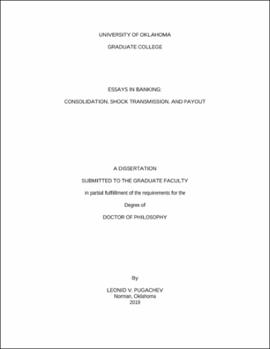| dc.description.abstract | This dissertation comprises three essays. The first documents the equilibrating effect of bank M&As on deposit and loan markets; the second explores board interlocks as a means of bank-shock transmission across sectors; the last investigates the value of payout to bank investors.
Chapter 1 examines deposit and loan volume and price changes around all ownership-changing U.S. bank M&As between 1998 and 2016. I find that M&A impacts target markets differently based on their deposit-loan imbalances. In markets where loans are scarce relative to deposits, lending (deposit-gathering) increases by more (less); where deposits are relatively scarce, the effects reverse. Thus, M&A reduces deposit-loan imbalances, equilibrating markets. Deposit-loan rebalancing correlates with better economic outcomes. Deposit and loan price analysis, however, is inconclusive. Overall, my findings support a welfare-enhancing view of bank M&A.
Chapter 2 uses 1,245 U.S. bank enforcement actions (EAs) issued between 1990 and 2017 to show that board interlocks transmit bank shocks into the real economy. When a non-financial firm (NFF) and bank share a common director, NFF stock prices fall around EAs issued to the bank. The effect is stronger for more severe EAs. During enforcement years, common directors participate less on NFF boards and more on bank boards. These results are unlikely to reflect an impaired credit relationship, director reputational damage, or endogenous director selection. They imply that board interlocks could transmit larger bank shocks into the real economy.
Chapter 3 reexamines whether investors value payout and why. I study abnormal stock returns around regulatory EAs that restrict bank dividends and repurchases. Market reactions are significantly worse for enforced banks that pay out than for those that do not. Withstanding alternative explanations and parallel trend concerns, these results present rare, causal evidence of a value to corporate distribution. The cross-section of abnormal returns suggests that risk-shifting, not agency cost reduction, drives payout. In my sample of distressed banks, especially around financial crises, the ability to shift risk through payout has value. | en_US |
